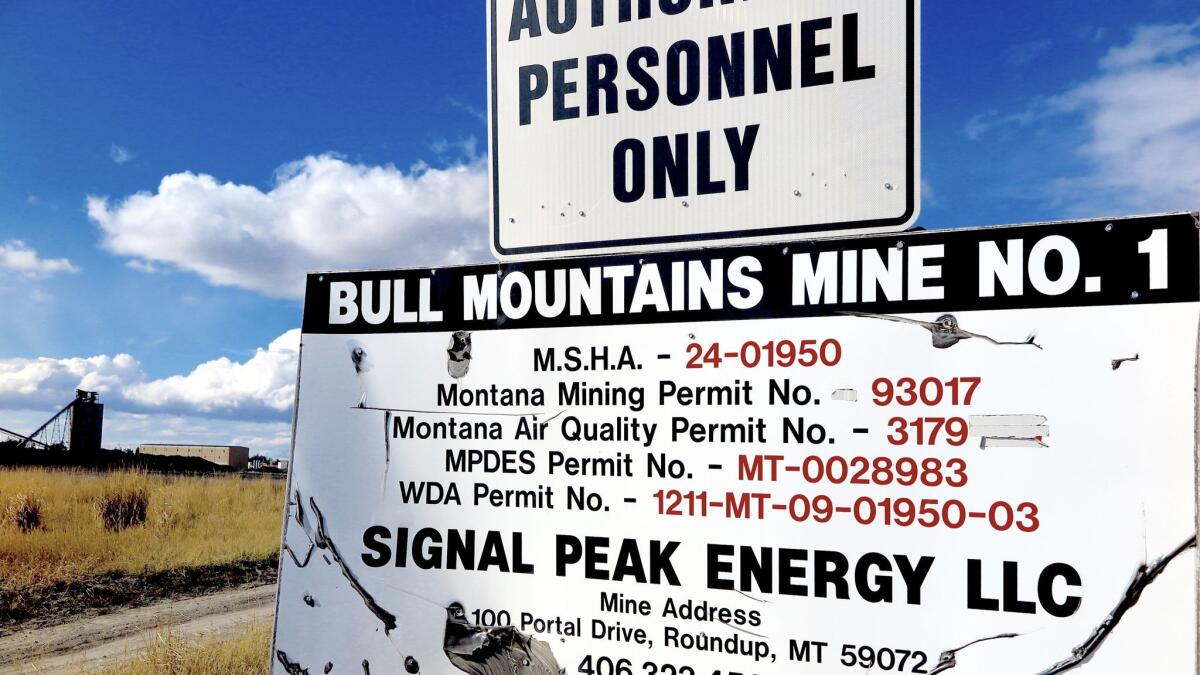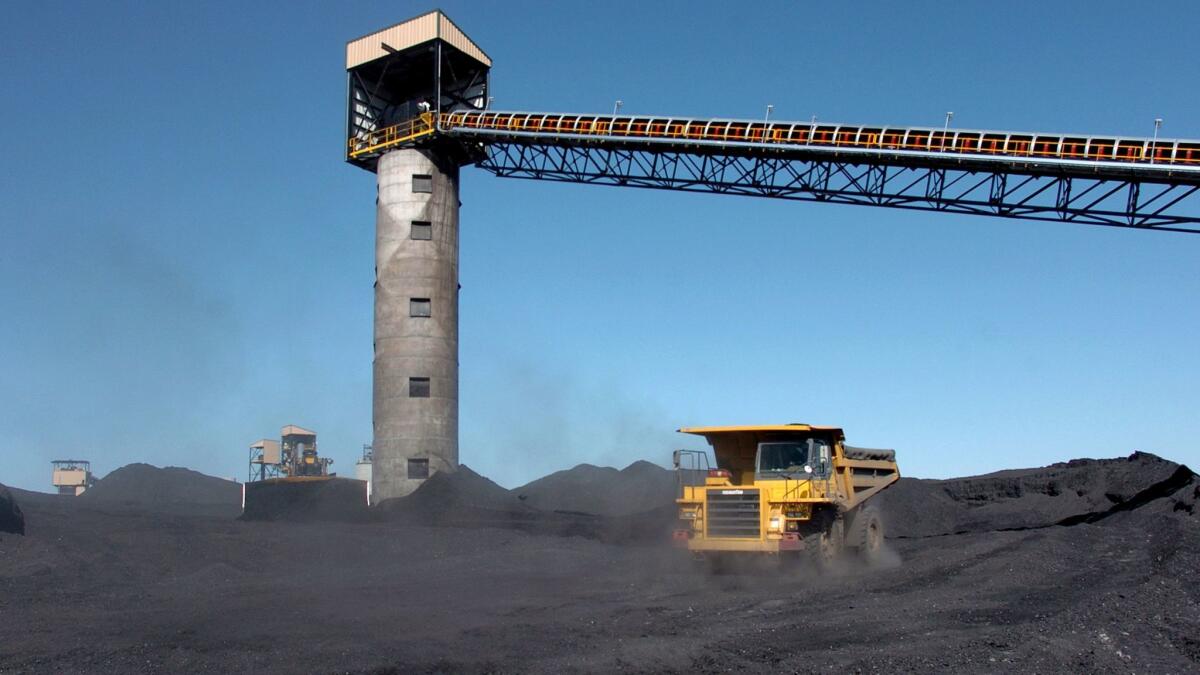Under Trump, the lines are drawn for a battle over resources in the West

- Share via
Reporting from ROUNDUP, Mont. — Signal Peak Energy operates the West’s newest and largest underground coal mine. As recently as 2013, it employed more than 300 people, produced nearly 9 million tons of coal and was helping to revive a regional coal industry that had been dormant for 50 years.
The last four years have seen a sharp reversal of the plant’s fortunes. Production is less than half of what it was. Layoffs have reduced the workforce by over 80 people. This month the company, which declined requests for interviews, said it might have to close more of its operations.
For the record:
3:50 p.m. Oct. 29, 2017An earlier version of this report referred to the Sabin Center for Climate Change Law as the Sabin Center for Environmental Law.
The rolling highlands of Musselshell County, close to Montana’s Bull Mountains, have quickly become a fiercely contested front line in the Trump administration’s campaign to achieve what it calls “American energy dominance.”
Nobody doubts that Signal Peak’s Bull Mountains mine, like nearly every other large coal mine in the United States, is in trouble. The disagreement arises over why. Answering that question motivated the Trump administration to mount an unbridled multi-agency attack on decades of policy and practices for overseeing land, water and natural resources, especially in the West. It also spurred environmentalists, courts, select industries, and state and federal lawmakers to form a powerful opposition coalition.
Nearly a year after the 2016 election, a momentous 21st century confrontation is building over coal mining that is serving as a proxy for upcoming skirmishes over the West’s rural extractive economies. The issue for both sides, as it was in the 1980s under the Reagan administration, is whether hard-rock mining, oil and gas, timber harvesting and irrigated agriculture will thrive or fade away.
For the time being, fossil fuel development commands the playing field. In his first major policy speech, delivered in late September, Interior Secretary Ryan Zinke laid out the contours of the administration’s perspective for an audience at the Heritage Foundation.
“There are two versions of our future in energy,” he said. “One side believes we should retreat into a fortress of regulation and red tape.”
“This administration, the president, believes in American energy dominance,” Zinke added. “Our goal is an America that is the strongest energy superpower this world has ever known. I can assure you today that the war on American energy is over.”

Not quite, say environmental legal groups and an array of supporters. The Trump administration, they assert, is fighting an unwinnable battle to sustain 20th century fuels and industrial practices against a tide of much more powerful 21st century trends in technology, energy markets, public sentiment, science and law.
The battled-tested legion of administration opponents is much larger, better financed and much better organized than it was during the Reagan years.
“Bring it on. We’re ready,” said Derf Johnson, staff attorney with the Montana Environmental Information Center in Helena. “Economically, what this president wants makes no sense. It’s like they want to walk back to the 1960s. Natural gas and renewable energy are replacing coal as a fuel for electricity.”

Johnson acknowledged that Trump’s arguments had struck a chord with many voters. “It’s hard to hear that a way of life is being challenged by a really big change in the economy of energy. The president is playing to his base,” he said.
The skirmish unfolding here in a central Montana county of 4,600 residents, where the president won more than 80% of the vote, illustrates several dimensions of a larger battle waged by politically influential but financially troubled resource industries, a sympathetic administration, and opponents allied to open the West to more environmentally sensitive economic sectors.
In 2008, four years before U.S. coal production peaked at nearly 1.2 billion tons, Signal Peak purchased a mine 30 miles north of Billings. The company installed modern mining machines, drilled 8,000-foot-deep water wells for a coal-washing station, built a rail-car loading facility and a 30-mile rail link to main trunk lines in Broadview, near Billings.
The company, which touts its coal as among the highest quality in the country, is ambitious. Twice it sought leases and permits to expand the mine. In 2012, Signal Peak paid $10.75 million and was awarded the federal lease to mine 100 million tons of coal that lay below 2,700 acres, doubling the mine’s size and turning it into the nation’s sixth-largest underground coal mine.
The American comeback story has waited too long to be written. With President Trump in office, our country is winning again.
— Interior Secretary Ryan Zinke
The same year, when coal prices were still robust and before China, India and the United States began to pivot away from coal-fired electrical generation, Signal Peak applied to state authorities to expand the mine by nearly 7,200 acres and add 176 million tons to its reserves.
It also asked the Interior Department for permission to modify its mining plan. Signal Peak anticipated being able to serve international export markets — its primary customers — with 11 million tons of coal annually, making it the largest underground mine in the United States.
In 2015, President Obama’s Interior Department approved Signal Peak’s expansion plan after ruling it would not have significant environmental consequences. The Montana Environmental Information Center and two other state environmental organizations sued in federal district court, arguing that such a conclusion lacked scientific validity and that the agency should prepare a full environmental impact statement.

One particular weakness in the Interior Department’s decision, said the center, was that it did not carefully assess the consequences of an increase in coal production on climate change.
In mid-August, U.S. District Judge Donald W. Molloy ruled in the center’s favor. His order vacated Signal Peak’s mining plan, directed the Interior Department to strengthen its analysis, and blocked the company’s expansion pending a new federal review of its environmental consequences.
Initially, Signal Peak’s executives said the decision would not affect its operations. But in mid-September, Bradley Hanson, the company’s president, said in a court filing that because the mine is close to exhausting its existing reserves, 30 employees could be laid off by the end of this month and 50 more by March.
Signal Peak asked Molloy to reconsider, and aided by Trump administration lawyers, the company also filed an appeal to the U.S. 9th Circuit Court of Appeals in San Francisco. Molloy has scheduled a hearing to consider the company’s motion for Tuesday.
The Signal Peak case was the seventh time environmental groups had successfully sued the government for not carefully evaluating the consequences of its decisions on the climate, according to research by Columbia University’s Sabin Center for Climate Change Law. Most of the cases challenged federal coal leases.
Among his first acts in office, Zinke sought to break through the federal leasing impediments and curb the legal strategy. On March 29, he lifted a moratorium on leasing established by the Obama administration in 2016. One week later, the White House canceled the Obama administration’s guidance document for helping federal agencies to more thoroughly consider climate effects in their decisions.
The two actions are among more than 40 policy changes taken this year by the president to tilt American energy policy in favor of the fossil fuel sector. Each has drawn active support and vigorous opposition.
They include withdrawing the United States from the 2015 international climate agreement, repealing the Clean Power Plan to regulate greenhouse gases from coal-fired power plants, adjusting land-use practices on public lands, ending a rule that prevented strip mines from dumping debris in streams, proposing to shrink the boundaries of national monuments, and intervening in a multi-state plan to conserve millions of acres in the West for the threatened sage grouse.
The administration also has proposed a rule to disrupt electricity markets and allow big coal-fired plants to stay open, and is considering a decision by the International Trade Commission to establish tariffs on imported solar panels.
“The American comeback story has waited too long to be written,” Zinke said in his speech. “With President Trump in office, our country is winning again. Energy, quite frankly, is driving the bus.”

In Montana and other fossil-fuel-producing states, the administration’s message and its actions are celebrated. “The war on coal must stop,” said Sandra Jones, an evangelical minister and mayor of Roundup, the Musselshell County seat that is 20 miles north of the Signal Peak mine. “Regulation is killing us here. We’re losing jobs. People are getting hurt. Coal pays for a lot of services in Montana.”
Environmental attorneys say they are sensitive to the personal pain and civic fragmentation occurring across the rural West. They assert, though, that the president’s campaign for “energy dominance” is an economic strategy that defies the law and no longer makes economic or environmental sense.
Global coal production peaked in 2013 at 8 billion metric tons and has been falling 1% to 2% annually in the years since. In the U.S., coal production fell to 743 million tons in 2016, almost 40% lower than the nearly 1.2-billion-ton peak in 2012, according to the Energy Information Administration, a Department of Energy data office.
In the meantime, investments worldwide in new generating capacity from wind and solar energy reached $286 billion in 2015, twice as much as investments in fossil-fuel-generated electricity, according to a study by the United Nations Environment Program.
ALSO
Trump’s inaction on climate change carries a big price tag, federal report finds
China is now looking to California – not Trump – to help lead the fight against climate change
More to Read
Sign up for Essential California
The most important California stories and recommendations in your inbox every morning.
You may occasionally receive promotional content from the Los Angeles Times.










